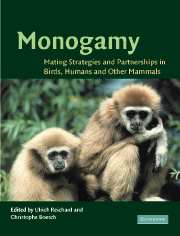Book contents
- Frontmatter
- Contents
- List of contributors
- Acknowledgements
- Introduction
- PART I Evolution of social monogamy
- CHAPTER 2 The evolution of monogamy: mating relationships, parental care and sexual selection
- CHAPTER 3 Mate guarding and the evolution of social monogamy in mammals
- CHAPTER 4 The evolution of social monogamy in primates
- CHAPTER 5 The evolution of social and reproductive monogamy in Peromyscus: evidence from Peromyscus californicus (the California mouse)
- PART II Reproductive strategies of socially monogamous males and females
- PART III Reproductive strategies of human and non-human primates
- Index
CHAPTER 5 - The evolution of social and reproductive monogamy in Peromyscus: evidence from Peromyscus californicus (the California mouse)
Published online by Cambridge University Press: 05 July 2014
- Frontmatter
- Contents
- List of contributors
- Acknowledgements
- Introduction
- PART I Evolution of social monogamy
- CHAPTER 2 The evolution of monogamy: mating relationships, parental care and sexual selection
- CHAPTER 3 Mate guarding and the evolution of social monogamy in mammals
- CHAPTER 4 The evolution of social monogamy in primates
- CHAPTER 5 The evolution of social and reproductive monogamy in Peromyscus: evidence from Peromyscus californicus (the California mouse)
- PART II Reproductive strategies of socially monogamous males and females
- PART III Reproductive strategies of human and non-human primates
- Index
Summary
INTRODUCTION
The genus Peromyscus (deer mice) is an attractive group in which to study the evolution of social and mating behaviours. This genus includes over 50 species (Carleton, 1989) that are widely distributed across North and Central America from coast to coast and from the northern subarctic to Panama (Kirkland & Layne, 1989). The diversity in body sizes among Peromyscus ranges from 13 to 77 g (Millar, 1989) and exceeds that of most other genera. Phylogenetic relationships among species of Peromyscus are relatively well understood (Stangl & Baker, 1984), although the systematics of Peromyscus is an active area of study (e.g., Rogers & Engstrom, 1992; Bradley et al., 2000). Most relevant to this chapter, populations and species of Peromyscus exhibit a variety of social behaviours and mating systems (Wolff, 1989), with social monogamy, and particularly reproductive monogamy, being relatively rare. Since monogamy is rare among Peromyscus, those Peromyscus species that exhibit monogamous behaviours may reveal important factors in the evolution of the genus.
One of the best studied monogamous species within the genus is P. californicus (California mouse). Association patterns, biparental care, and mating exclusivity indicate that this species is socially and reproductively monogamous, and I will begin by reviewing these elements. Furthermore, recent field experiments demonstrate that male care is critical for offspring survival and is the salient feature of monogamy in this species. I will then review the ecology of female and male home range use and spatial organization and paternal care in other Peromyscus species.
- Type
- Chapter
- Information
- MonogamyMating Strategies and Partnerships in Birds, Humans and Other Mammals, pp. 81 - 92Publisher: Cambridge University PressPrint publication year: 2003
- 18
- Cited by



